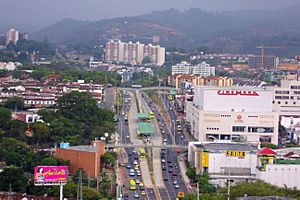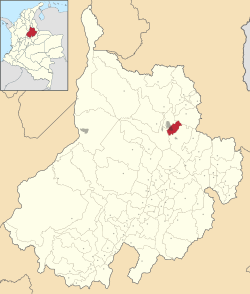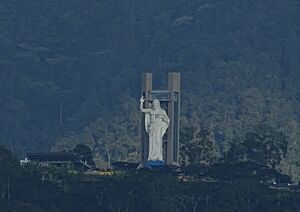Floridablanca, Santander facts for kids
Quick facts for kids
Floridablanca
|
|||
|---|---|---|---|

View of Cañaveral, the central hotspot of Floridablanca
|
|||
|
|||

Location of Floridablanca in Santander
|
|||
| Country | Colombia | ||
| Region | Andes | ||
| Department | Santander | ||
| Province | Soto | ||
| Founded | 7 November 1817 | ||
| Founded by | Javier Guerra de Mier | ||
| Area | |||
| • Municipality | 100.3 km2 (38.7 sq mi) | ||
| • Urban | 17.04 km2 (6.58 sq mi) | ||
| Elevation | 925 m (3,035 ft) | ||
| Population
(2020 est.)
|
|||
| • Municipality | 307,896 | ||
| • Density | 3,069.8/km2 (7,951/sq mi) | ||
| • Urban | 295,724 | ||
| • Urban density | 17,355/km2 (44,948/sq mi) | ||
| Demonym(s) | Florideño | ||
| Time zone | UTC-5 | ||
| Area code(s) | 57 + 7 | ||
Floridablanca, also known as Florida, is a city in Colombia. It is located in the Santander region. The city sits high up in the Andes mountains, about 925 metres (3,035 ft) above sea level. It is part of the larger city area of Bucaramanga, the capital of Santander.
Floridablanca is famous for its beautiful parks. It is also known for the Piedra del Sol. This is a large rock with spirals and circles carved by the Guane people over 1,000 years ago. The city is home to "El Santisimo," the tallest statue of Jesus Christ in Colombia. This huge statue is 40 metres (130 ft) tall and weighs 40 tonnes (88,000 lb). Floridablanca is growing quickly, with many new buildings being built.
Contents
Exploring Floridablanca's Location and Weather
Floridablanca is located about 925 metres (3,035 ft) high in the Eastern Ranges of the Colombian Andes. The land around the city changes a lot. East of the city, you can see taller mountains. These mountains were pushed up by a large crack in the Earth called the Bucaramanga-Santa Marta Fault.
The area is also known for the Bucaramanga Nest. This is the second most active earthquake zone in the world. Because the city is not too high up, it has pleasant weather all year. Floridablanca has a tropical climate. This means it gets a lot more rain in the summer than in winter. The average temperature in Floridablanca is 23.6 °C (74.5 °F). The city gets about 1,055 millimetres (41.5 in) of rain each year.
| Weather chart for Floridablanca - 925 m (3,035 ft) | |||||||||||||||||||||||||||||||||||||||||||||||
|---|---|---|---|---|---|---|---|---|---|---|---|---|---|---|---|---|---|---|---|---|---|---|---|---|---|---|---|---|---|---|---|---|---|---|---|---|---|---|---|---|---|---|---|---|---|---|---|
| J | F | M | A | M | J | J | A | S | O | N | D | ||||||||||||||||||||||||||||||||||||
|
58
29
19
|
71
29
19
|
90
29
20
|
118
28
19
|
108
29
19
|
82
28
19
|
59
29
19
|
80
29
19
|
92
29
19
|
139
28
19
|
101
28
19
|
57
28
19
|
||||||||||||||||||||||||||||||||||||
| temperatures in °C precipitation totals in mm source: Climate-data.org - Floridablanca |
|||||||||||||||||||||||||||||||||||||||||||||||
|
Imperial conversion
|
|||||||||||||||||||||||||||||||||||||||||||||||
Discovering Floridablanca's History
Before the Spanish arrived, the Guane people lived in the area of Floridablanca. The Guane became part of the Spanish Empire in 1539. This happened when Martín Galeano, a Spanish explorer, founded the city of Vélez.
Modern Floridablanca was officially started on November 7, 1817. It was founded by Javier Guerra de Mier. The city was first named "Floridablanca de San Juan Nepomuceno." The church of San Juan Nepomuceno was finished in 1832.
Understanding Floridablanca's Population
According to official numbers, Floridablanca has 262,165 people living there. This makes it the second most populated city in Santander. About 47.37% of the people are men, and 52.63% are women. Most people over five years old know how to read and write. Only about 4.4% of the population cannot read or write.
Many adults living in Floridablanca originally came from other places:
- 7.7% are from Floridablanca itself.
- 44% are from Bucaramanga.
- 33% are from other cities in Santander.
- 16% are from other parts of Colombia.
Floridablanca's Economy and Tourism

Floridablanca has a lively economy. A study from 1998 showed that trade was the biggest part of the economy. It made up 39% of all money-making activities. Making clothes was nearly 10% of the economy. The food and drinks industry was about 7%.
Floridablanca is famous for making sweets. It is especially known for traditional Colombian desserts called obleas. Because of this, Floridablanca is sometimes called "the sweet municipality of Colombia."
The city center has many shopping malls. Cañaveral Mall opened in 1984. Parque Caracolí Mall opened in 2013.
Floridablanca is also a gateway to the Chicamocha Canyon. This amazing canyon is about an hour's drive from the city. You can even go paragliding from the Mesa de Ruitoque, a high area southwest of the city. Buses to tourist spots like San Gil and the Chicamocha Canyon leave from a station called "Papi Quiero Piña." This means "Dad, I want pineapple."
The Jardín Botánico Eloy Valenzuela is a botanical garden in Floridablanca. It used to belong to a tobacco company. In 2017, Floridablanca was named one of Colombia's five "sustainable touristic destinations." This means it's a great place to visit that also cares for the environment.
Schools in Floridablanca
Here are some of the schools you can find in Floridablanca:
- Colegio Santa Isabel de Hungría
- La Quinta del Puente
- Colegio Nuevo Cambridge
Panoramas
See also
 In Spanish: Floridablanca (Colombia) para niños
In Spanish: Floridablanca (Colombia) para niños







